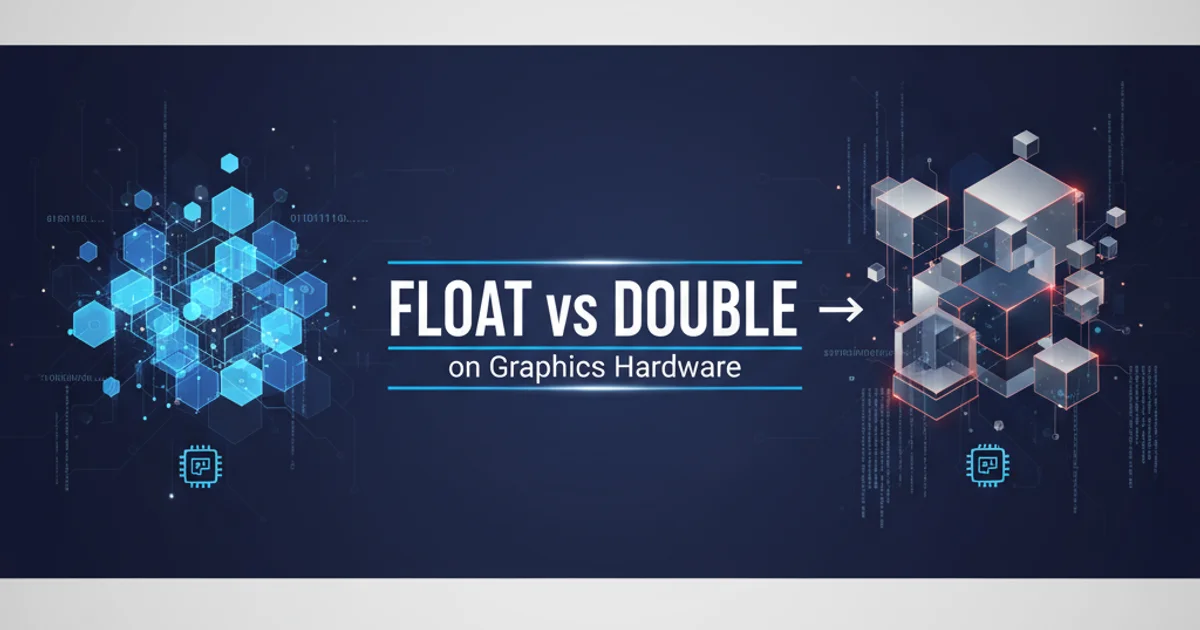float vs double on graphics hardware
Categories:
Float vs. Double Precision in Graphics Hardware: A Deep Dive

Explore the critical differences between float and double precision floating-point numbers in the context of graphics programming, understanding their impact on performance, precision, and hardware support.
When developing graphics applications, especially those involving complex calculations like physics simulations, ray tracing, or high-precision rendering, a fundamental decision arises: should you use float or double for your floating-point numbers? This choice has significant implications for performance, memory usage, and the visual fidelity of your output. This article delves into the technical distinctions, hardware considerations, and practical advice for making the right choice in your graphics projects.
Understanding Floating-Point Precision
Floating-point numbers are used to represent real numbers, which can have fractional parts. The IEEE 754 standard defines the most common formats for these numbers. The primary difference between float (single-precision) and double (double-precision) lies in the number of bits allocated to store them, directly impacting their range and precision.
pie title Floating-Point Bit Allocation
"Sign Bit" : 1
"Exponent (float)" : 8
"Mantissa (float)" : 23
"Exponent (double)" : 11
"Mantissa (double)" : 52Bit allocation for single-precision (float) and double-precision (double) floating-point numbers.
A float uses 32 bits, providing approximately 7 decimal digits of precision and a range of about (10^{-38}) to (10^{38}). In contrast, a double uses 64 bits, offering roughly 15-17 decimal digits of precision and a much wider range of about (10^{-308}) to (10^{308}). This increased precision of double is crucial for calculations where small errors can accumulate and lead to noticeable inaccuracies, such as in large-scale world coordinates or intricate physics systems.
Hardware Support and Performance Implications
Historically, graphics hardware (GPUs) has been optimized for float operations. This is because many graphics tasks, such as vertex transformations, texture lookups, and pixel shading, often do not require the extreme precision of double and benefit greatly from the higher throughput of float calculations. Modern GPUs, however, have significantly improved their double precision capabilities, though float operations typically remain faster and consume less memory.
flowchart TD
A[Graphics Pipeline Stage]
A --> B{Precision Requirement?}
B -->|Low/Standard| C[Use float (Faster, Less Memory)]
B -->|High/Critical| D[Use double (Slower, More Memory)]
C --> E[GPU Optimized for float]
D --> F[GPU Double Precision Units]
E --> G[Rendered Output]
F --> GDecision flow for choosing float vs. double in graphics pipelines.
When a GPU performs double precision calculations, it often requires more clock cycles or dedicated processing units, leading to lower throughput compared to float operations. This performance difference can be substantial, especially on consumer-grade GPUs. For example, a GPU might have a double precision throughput that is 1/2, 1/4, or even 1/32 of its float throughput. Memory bandwidth is another factor; double values consume twice the memory of float values, which can impact performance due to increased data transfer.
double precision can vary significantly between different GPU architectures and workloads.Practical Considerations and Use Cases
The choice between float and double is a trade-off. For most visual effects, float is perfectly adequate and offers the best performance. However, there are specific scenarios where double precision becomes essential:
When to use float (single-precision):
// Common usage in GLSL shaders for performance
precision highp float;
void main() {
vec3 position = vec3(0.5f, 1.2f, -0.3f);
// ... many calculations using floats
gl_Position = projection * view * model * vec4(position, 1.0);
}
Example of float usage in a GLSL shader.
- Vertex Positions and Normals: For typical scene sizes,
floatprovides enough precision to avoid visual artifacts like 'jitter' or 'z-fighting'. - Texture Coordinates:
floatis standard for UV coordinates. - Color Values: RGB components are usually represented by
floatvalues between 0.0 and 1.0. - Most Shader Calculations: General lighting, material properties, and post-processing effects often don't require
doubleprecision. - Performance-Critical Applications: When maximum frame rates are paramount,
floatis the go-to choice.
When to consider double (double-precision):
// Example of using double for high-precision physics or large-scale worlds
// Note: GLSL support for 'double' varies by hardware and GLSL version.
#version 450 core
layout(location = 0) in dvec3 in_position_double;
uniform dmat4 projection_double;
uniform dmat4 view_double;
uniform dmat4 model_double;
void main() {
dvec4 world_pos = model_double * dvec4(in_position_double, 1.0);
gl_Position = projection_double * view_double * world_pos;
}
Example of double usage in a GLSL shader (requires GLSL 4.0+ and hardware support).
- Large-Scale Worlds/Planetary Rendering: When dealing with coordinates spanning vast distances,
floatprecision can lead to 'jitter' or 'swimming' artifacts far from the origin.doubleprecision helps maintain accuracy. - Physics Simulations: Accumulation of small errors in physics calculations (e.g., rigid body dynamics, fluid simulations) can lead to unstable or incorrect behavior over time.
doubleprecision mitigates this. - Scientific Visualization: Applications requiring extremely accurate data representation, such as medical imaging or scientific simulations.
- Ray Tracing (specific cases): While many ray tracers use
float, complex intersection tests or very long rays in large scenes might benefit fromdoubleprecision to avoid missed intersections or incorrect hit points. - CAD/CAM Applications: Where absolute precision is critical for design and manufacturing.
float and double in calculations can lead to implicit conversions, which might incur performance penalties or unexpected precision loss. It's generally best to stick to one precision type within a given calculation chain.